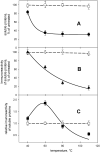Quantification of Protein "Biomarkers" in Wheat-Based Food Systems: Dealing with Process-Related Issues
- PMID: 35565988
- PMCID: PMC9100356
- DOI: 10.3390/molecules27092637
Quantification of Protein "Biomarkers" in Wheat-Based Food Systems: Dealing with Process-Related Issues
Abstract
Selected food proteins may represent suitable markers for assessing either the presence/absence of specific food ingredients or the type and intensity of food processes. A fundamental step in the quantification of any protein marker is choosing a proper protocol for solubilizing the protein of interest. This step is particularly critical in the case of solid foods and when the protein analyte is prone to undergo intermolecular disulfide exchange reactions with itself or with other protein components in the system as a consequence of process-induced unfolding. In this frame, gluten-based systems represent matrices where a protein network is present and the biomarker proteins may be either linked to other components of the network or trapped into the network itself. The protein biomarkers considered here were wheat gluten toxic sequences for coeliac (QQPFP, R5), wheat germ agglutinin (WGA), and chicken egg ovalbumin (OVA). These proteins were considered here in the frame of three different cases dealing with processes different in nature and severity. Results from individual cases are commented as for: (1) the molecular basis of the observed behavior of the protein; (2) the design of procedure aimed at improving the recovery of the protein biomarker in a form suitable for reliable identification and quantification; (3) a critical analysis of the difficulties associated with the plain transfer of an analytical protocol from one product/process to another. Proper respect for the indications provided by the studies exemplified in this study may prevent coarse errors in assays and vane attempts at estimating the efficacy of a given treatment under a given set of conditions. The cases presented here also indicate that recovery of a protein analyte often does not depend in a linear fashion on the intensity of the applied treatment, so that caution must be exerted when attributing predictive value to the results of a particular study.
Keywords: biomarkers; egg; food proteins; gluten; immunochemistry; lectin; ovalbumin; pasta; whole grain.
Conflict of interest statement
The authors declare no conflict of interest.
Figures


Similar articles
-
Wheat Germ Agglutinin (WGA): Its Nature, Biological Role, Significance in Human Nutrition, and Possibility to Be Used as Marker of Whole-Grain Status in Wheat-Based Foods.Foods. 2024 Sep 21;13(18):2990. doi: 10.3390/foods13182990. Foods. 2024. PMID: 39335918 Free PMC article. Review.
-
Wheat gluten functionality as a quality determinant in cereal-based food products.Annu Rev Food Sci Technol. 2012;3:469-92. doi: 10.1146/annurev-food-022811-101303. Epub 2011 Dec 12. Annu Rev Food Sci Technol. 2012. PMID: 22224557 Review.
-
Defining the wheat gluten peptide fingerprint via a discovery and targeted proteomics approach.J Proteomics. 2016 Sep 16;147:156-168. doi: 10.1016/j.jprot.2016.03.015. Epub 2016 Mar 16. J Proteomics. 2016. PMID: 26994601
-
Innovative approach to low-level gluten determination in foods using a novel sandwich enzyme-linked immunosorbent assay protocol.Eur J Gastroenterol Hepatol. 2003 May;15(5):465-74. doi: 10.1097/01.meg.0000059119.41030.df. Eur J Gastroenterol Hepatol. 2003. PMID: 12702901
-
Lectin activity of gluten identified as wheat germ agglutinin.Biochem Biophys Res Commun. 1985 Jul 31;130(2):867-72. doi: 10.1016/0006-291x(85)90496-6. Biochem Biophys Res Commun. 1985. PMID: 3839672
Cited by
-
Wheat Germ Agglutinin (WGA): Its Nature, Biological Role, Significance in Human Nutrition, and Possibility to Be Used as Marker of Whole-Grain Status in Wheat-Based Foods.Foods. 2024 Sep 21;13(18):2990. doi: 10.3390/foods13182990. Foods. 2024. PMID: 39335918 Free PMC article. Review.
References
-
- Senyuva H.Z., Jones I.B., Sykes M., Baumgartner S. A critical review of the specifications and performance of antibody and DNA-based methods for detection and quantification of allergens in foods. Food Addit. Contam. Part A Chem. Anal. Control Expo. Risk Assess. 2019;36:507–547. doi: 10.1080/19440049.2019.1579927. - DOI - PubMed
-
- Bonomi F., Iametti S. Thiolomics of the Gluten Protein Network of Wheat Dough. In: Wrigley C., Corke H., Seetharaman K., Faubion J., editors. Encyclopedia of Food Grains 2: Nutrition and food grains. Volume 2. Elsevier; Amsterdam, The Netherlands: 2016. pp. 154–160.

